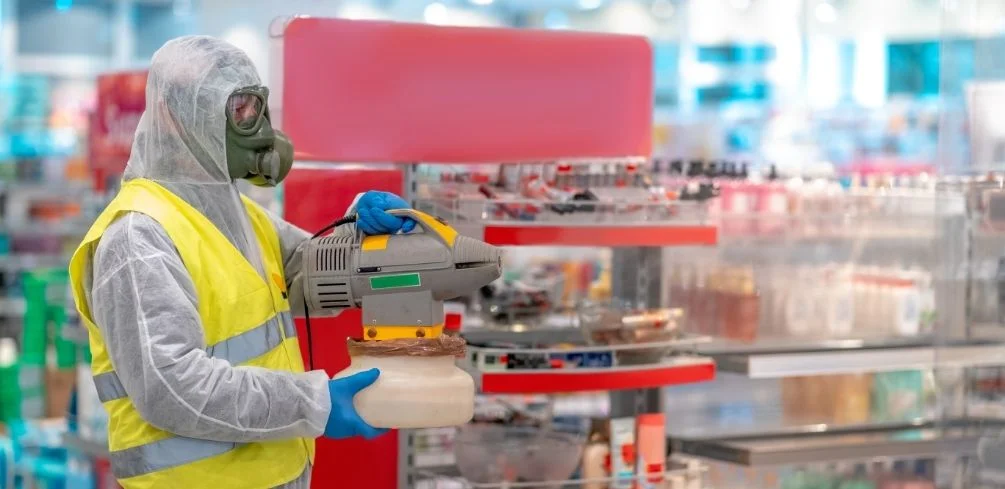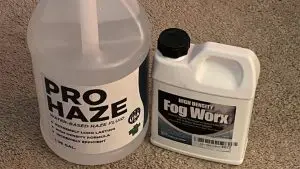Electrostatic sprayers and foggers are both good at the job, but most people tend to prefer electrostatic sprayers because they are generally cheaper than foggers. Foggers are great for disinfecting large spaces. They also have other uses including producing fog for parties or events.
If you’re familiar with disinfection terminology, you’ve certainly heard terms like electrostatic sprayer and fogger, thrown around a lot. Many people believe that all of these terms refer to the same tool, something that isn’t entirely accurate.
However, despite their apparent similarities, electrostatic sprayers and foggers were developed for very different objectives and deliver very different results.
What Exactly Is Fogging?
Fogging is primarily used for the application of cleaning agents through the use of a fog machine. The fogging machine creates fog or mist composed of extremely small droplets, which are emitted by the machine.
During fogging it is not necessary to move furniture or equipment for disinfection or sanitization to be effective because airborne and surface-based pathogens are destroyed through vaporization of the environment.
One of the quickest and easiest ways to disinfect large areas is to use fogging. Fogging disinfects the air and, to some extent, any surface or area toward which the fog machine is directed.
What Is Electrostatic Spraying And How Does It Work?
Electrostatic spraying is a technique for applying a very thorough and even coating of a disinfectant or sanitizer to a variety of surfaces and objects. When a solution is sprayed through the device, an electric charge is applied to the solution, resulting in a wrapping effect being created.
Electrostatic spraying can achieve complete coverage because of the positively charged particles in the spray because they allow the appropriate disinfectants to wrap around and evenly coat all types of surfaces.
Electrostatic spraying disinfects any surface or object that the equipment is pointed at; however, it also wraps around objects to ensure a more thorough coating of disinfectant is applied to all surfaces and objects.
What Situations Call For Fogging?
When disinfection is required in large open spaces, fogging is the best option because it is quick and disinfectant can be sprayed up to 15 meters or further, reaching all the hard-to-reach areas.
The use of fogging in a facility in the event of a virus outbreak is also possible, primarily due to the speed with which it can be implemented.
However, it is important to note that this would be considered part of the cleaning process. Not to mention the protective gear, safety requirements, and downtime required after fogging has been completed.
What Situations Call For Electrostatic Spraying
Electrostatic spraying, on the other hand, is intended for use in high-touch disinfection/sanitization situations.
This is more easily incorporated into cleaning regimes, and because the spray is only up to 1m in length, it is designed for use on touchpoint surfaces.
There are significant time and chemical savings since it is enclosed and provides a very thorough even layer of disinfectant that is much more thorough than traditional trigger spray application.
Do Fogging And Spraying Have Different Purposes?
Fogging
Fogging is generated by using a machine that creates particles that are so small that they are able to float in the air. Fogging, in contrast to spraying, is a “dry” method of disinfection.
An entire room can be easily disinfected with the use of fogging. It is critical that you do not enter the room while the treatment is taking place.
By sprinkling drops of water onto the surface, a film is formed. This will cause the surface to become wet. The surface that is to be disinfected must remain wet until the contact time has expired.
Only in this manner can you be certain that a surface has been effectively disinfected. In the legal instructions for use, it is specified how long the disinfectant should be in contact with the skin.
Electrostatic Spraying
Spraying surfaces with an electrostatic sprayer ensures that even the most complex surfaces are uniformly covered by the spray droplets, which are precisely targeted.
The equipment used for fogging, on the other hand, can only be used in emptied spaces with areas that must be closed off for an extended period.
There is a significant difference between spraying and fogging, which is primarily determined by the size of the particles. To spray effectively, the particles must be very minute in size.
The minute particles will fall to the ground and on the surface as a result of this.
Fogging is caused by particles that are smaller than electrostatic spray particles. This keeps them afloat in the air and prevents them from getting wet on the surface of objects.
Factors to Consider Before Choosing Electrostatic Spraying or Fogging
Whether you disinfect wet or dry, it is critical to consider whether you will disinfect wet or dry before proceeding. Using wet disinfection is what you’ll be doing if you’re spraying your surfaces.
As a result, you must take into consideration, for example, any electronic equipment that may be present in the space.
Dry disinfection is referred to as fogging. The use of fogging allows all electronics to remain in the treatment room throughout the treatment process.
When using an electrostatic sprayer, the spray droplets are given an electric charge, causing them to be naturally attracted to the surfaces being sprayed. Each charged liquid particle is attracted to a surface in the same way that opposite poles of a magnet are attracted to each other.
This targeted spraying results in less wasteful overspray and more uniform coverage than traditional spraying methods. The size of the droplets ranges from approximately 50 to 100 nanometers.
Because you only have to wait until surfaces are dry, which is usually less than 15 minutes, occupancy delays are minimal when spraying.
Four Reasons Why Electrostatic Spraying Is Better Than Fogging
Provides the ability for the user to exercise control
Electrostatic spraying gives the user the ability to work across a whole room from various angles while remaining in complete control of the process from beginning to end. It is possible for fogging to miss areas because it relies on a machine to do the work with no user present.
The user has complete control over the disinfectant volume
Left to right and up and down are the only directions that electrostatic spraying can move in at any given time. The volume of the spray can be adjusted by the user.
Fogging necessitates the use of significantly more liquid, which is frequently excessive, at a higher cost.
It has a lower amount of downtime
Electrostatic spraying requires less downtime than traditional spraying. Immediately after a room has been electrostatically cleaned and dried, it can be re-entered without removing the electrostatic spray.
Fogging can mean that an environment is generally locked down and cannot be accessed for several hours straight.
It is effective and efficient
Because of the magnetic adhesion of the spray to the surfaces, electrostatic spraying can reach hidden and shadowed areas, with only a small amount of product falling to the floor. As much product as possible can be pushed into the air by fogging, but much of it may not reach all surfaces.
Choosing Between Electrostatic Sprayers and Foggers
Disinfecting surfaces and objects with foggers and electrostatic sprayers are both important solutions to sanitization. Because they leave less room for error and are less likely to result in cross-contamination issues than spray-and-wipe techniques, either is a superior alternative.
What you choose from the two options is determined by the space you’re cleaning and the time available. Either choice will produce similar results in a sparsely furnished room.
A room is better suited to an electrostatic sprayer if it has more odd shapes or objects in it.
Using a single-use fogger when disinfecting large spaces may be the safer option if you’re concerned about safety during disinfection. There are so many different fog machines uses.
Final Thoughts
The choice between an electrostatic sprayer and a fogger entirely depends on your specific needs and preferences. Both are good at the job, but most people tend to prefer electrostatic sprayers because they are generally cheaper than foggers.
Foggers are great for disinfecting large spaces. They also have other uses, including producing fog for parties or events.
Did you know there are also microfoggers. Learn what a Microfogger is here.
Please be careful and use at your own risk
None of the authors, contributors, administrators, or anyone else connected with Wild Fog, in any way whatsoever, can be responsible for your use of the information contained in or linked from these web pages.











